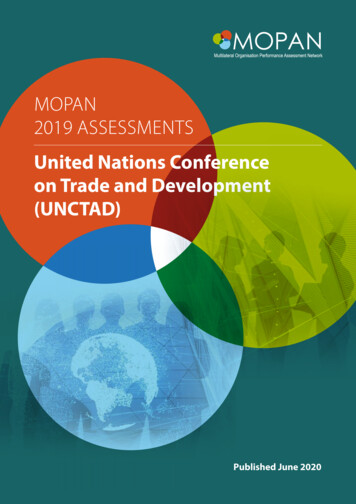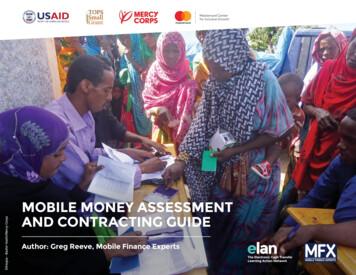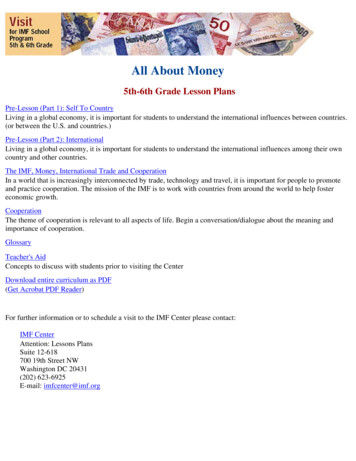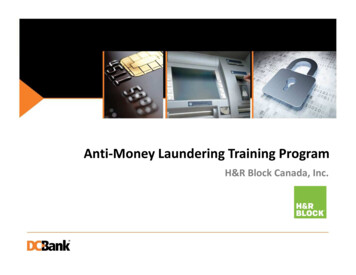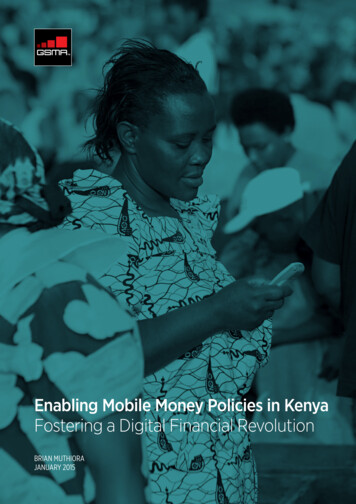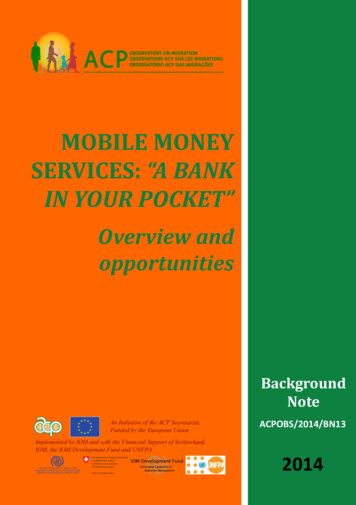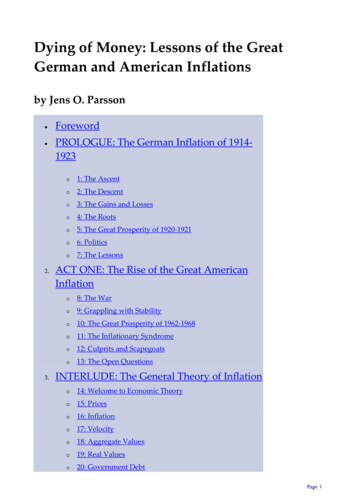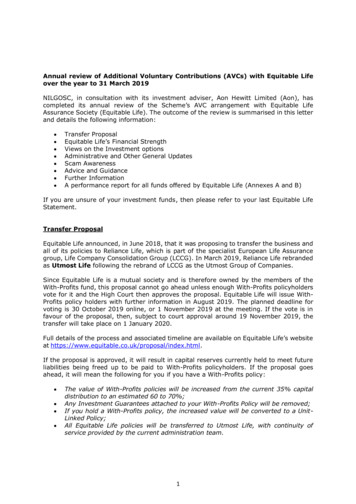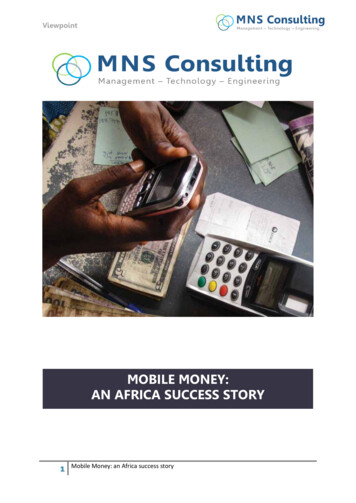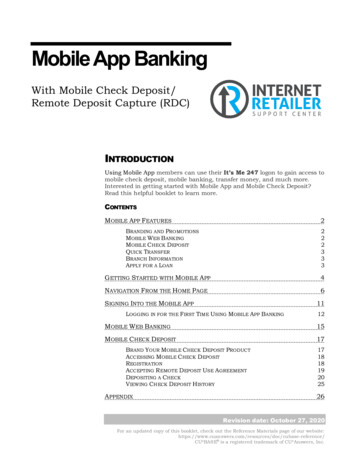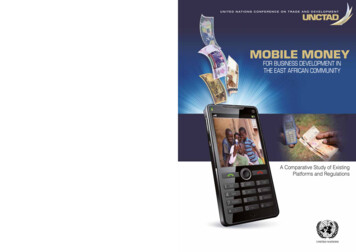
Transcription
UNCTADUNCTADU nUi ntei tde dn antaiot inosn Cs oCnofnefreerneCneC oe no nt rtardaed ae nadn d edveevleolpompemnetn tMobileMobileMoneyMoneyPrinted at United Nations, Geneva – GE.12-50897–June 2012–1,260–UNCTAD/DTL/STICT/2012/2Photo credit: Ismail KezaalaUNITED NATIONSUNITED NATIONSPhoto credit: Ismail KezaalaMobile Money for Business Development in the east african communityMobile Money for Business Development in the east african ityA ingPlatformsPlatformsandandRegulationsRegulations
iimobile money for business development in the eacNOTEWithin the UNCTAD Division on Technology and Logistics, the ICT Analysis Section carries out policy-orientedanalytical work on the development implications of information and communication technologies (ICTs). It is responsible for the preparation of the Information Economy Report as well as thematic studies on ICT for Development. The ICT Analysis Section promotes international dialogue on issues related to ICTs for development, andcontributes to building developing countries’ capacities to measure the information economy and to design andimplement relevant policies and legal frameworks.Reference to companies and their activities should not be construed as an endorsement by UNCTAD of thosecompanies or their activities.The following symbols have been used in the tables:Two dots (.) indicate that data are not available or are not separately reported. Rows in tables have been omittedin those cases where no data are available for any of the elements in the row;A dash (–) indicates that the item is equal to zero or its value is negligible;A blank in a table indicates that the item is not applicable, unless otherwise indicated;A slash (/) between dates representing years, e.g. 1994/95, indicates a financial year;Use of an en dash (–) between dates representing years, e.g. 1994–1995, signifies the full period involved, including the beginning and end years;Reference to “dollars” ( ) means United States dollars, unless otherwise indicated;Annual rates of growth or change, unless otherwise stated, refer to annual compound rates;Details and percentages in tables do not necessarily add up to the totals because of rounding.The material contained in this study may be freely quoted with appropriate acknowledgement.UNITED NATIONS PUBLICATIONUNCTAD/DTL/STICT/2012/2Copyright United Nations, 2012All rights reserved. Printed in Switzerland
PREFACEiiiPrefaceIn 2006, the Council of Ministers of the East African Community (EAC) identified the creation of a regional enablinglegal and regulatory environment as a critical enabling factor for the effective implementation of e-Governmentand e-commerce strategies at national and regional levels. Under its mandate to offer technical assistance todeveloping countries in the area of legal and regulatory reform related to information and communication technology (ICT), the United Nations Conference on Trade and Development (UNCTAD) has since been assisting EAC inbuilding a harmonized framework for cyberlaws across the five Partner States. As a result, EAC Legal Frameworkfor Cyber Laws Phase I – covering electronic transactions, electronic signatures and authentication, cyber crimeas well as data protection and privacy – was adopted in 2010 by EAC Council of Ministers on Transport, Communications, and Meteorology. It is being implemented at national level. Phase II of the Framework is expected tobe examined and adopted in 2012, covering intellectual property rights, competition, e-taxation and informationsecurity.Adoption of harmonized cyberlaw frameworks and transposition of such frameworks into national laws are essential to ensure an adequate legal response to challenges and opportunities raised by the increasing adoption ofinformation and communication technologies (ICTs). The rapid spread of mobile phone services in money transactions, which are a potentially great contributor to the region’s economic development and establishment of thecommon market has added urgency to the need for an effective and robust legal and regulatory framework. EAChas been ahead of other parts of the world in electronic money transfers, with M-PESA which started operatingin Kenya in 2007, having taken the lead in terms of innovation for providing more inclusive access to finance to alarge part of the population who hitherto had been without a bank account.Mobile commerce at large is gaining importance in many developing countries. From the perspective of smallbusinesses, mobile solutions can be applied to facilitate money transfers as well as merchant, bill and salarypayments. More sophisticated financial services, such as credit, savings and insurance schemes, are also likelyto expand in the coming years. Their successful implementation will require that mobile network operators enterinto effective partnerships with banks, micro-finance institutions, insurance companies or other organizations. Itwill also require that consumers and business users be able to trust the systems on offer.In this context, Governments must address a range of policy challenges and issues to ensure positive outcomesfrom the introduction of mobile money services. Developments in East Africa or of particular relevance in this context, as countries in this region are at the frontier in terms of mobile money deployments and are actively seekingto draw maximum benefits from this new opportunity.This comparative study of existing mobile money platforms and regulations in EAC contributes to our pool ofknowledge in this area. It was conducted as a part of the work on ICT for development conducted by UNCTAD.The principle consultant responsible for drafting the study was Ali Ndiwalana. The study was prepared by a teamfrom UNCTAD comprising Torbjörn Fredriksson and Cécile Barayre, under the direct supervision of Mongi Hamdiand overall guidance of Anne Miroux. Statistical, administrative and secretarial support was provided at variousstages by Smita Barbattini and Agnes Collardeau-Angleys.Valuable comments and inputs were received from Robert Achieng, Luca Castellani, Xavier Faz, Shruti Kashyap,Diana Korka, Rémi Lang, George Lwevoola, Stephen Mwaura, Michael Tarazi, Dr. Jovita Okumu and Ian Walden.Special thanks are also given to the members of EAC Task Force on Cyberlaw, as well as the many representatives of Government ministries, financial and regulatory institutions, universities and the private sector in EACwho were interviewed and gave feedback during the course of the study.Financial support from the Government of Finland is gratefully acknowledged.
CONTENTSvCONTENTSPreface.iiiList of Abbreviations.ixA. Introduction.11. Players involved in the Mobile Money ecosystem. 22. Mobile Money Platforms in EAC. 3B. Services and fees.51. Types of Services. 51.1. M-transfers. 51.2. M-payments. 71.3. M-financial services. 72. Service fees. 8C. Salient features of EAC mobile money services deployments.121.2.3.4.5.Access channels. 12Security. 13Registration and transaction limits. 14Agent networks. 15Consumer awareness and support. 16D. Regulation and Policy.171. Introduction. 172. Legal and regulatory areas of relevance to Mobile Money . 172.1. E-Commerce legislation. 182.2. Consutmer protection. 192.3. Privacy and data protection. 202.4. Telecommunications. 202.5. Financial Regulation. 212.6. Competition law . 243. Selected issues. 253.1. Convergence of different regulatory areas. 253.2. User security issues. 263.3. Handling deposits . 263.4. Cross-border transfers . 28E. Conclusions and recommendations.291.2.3.4.5.6.Consumer protection. 29Registration and transaction limits. 30Agent networks. 31Interoperability. 31Government and taxation. 32Regulator collaboration. 33ANNEX: Mobile Money Country Profiles .34A. Burundi.341. Relevant legislation. 341.1. Financial regulation. 341.2. Other regulation. 342. Players. 34
vimobile money for business development in the eac3. Services. 344. Costs. 35B. Kenya.361. Relevant legislation. 361.1. Financial regulation. 361.2. Other legislation. 362. Players. 363. Services. 374. Costs. 37C. Rwanda.411. Relevant legislation. 411.1. Financial regulation. 411.2. Other legislation. 422. Players. 433. Services. 434. Costs. 43D. The United Republic of Tanzania.451. Relevant legislation. 451.1. Financial regulation. 451.2. Other regulation. 452. Players. 453. Services. 464. Costs. 46E. Uganda.491. Relevant legislation. 491.1. Financial legislation. 491.2. Other legislation. 492. Players. 493. Services. 504. Costs. 52List of Interviewees.54
CONTENTSBoxes1.2.What is mobile money?. 1Methodology. 2Tables1.2.Mobile Money snapshot across the East African Community (as at 3: August 2011). 3Mobile network operators, their mobile money platforms and bank partners across the East AfricanCommunity, December 2011. 43. Categorisation of different Mobile Money services available in the East African Community. 64. MTN MobileMoney fees for M-transfers in Uganda (sending and receiving). 95. Safaricom M-PESA fees for M-transfers in Kenya. 96. Cost comparison of sending M-transfers to registered and non-registered users across mobile moneyplaforms in Uganda. 107. Cost comparison of sending M-transfers to registered and non-registered users across mobile moneyplatforms in Kenya. 108. MTN MobileMoney fees for M-Payments in Uganda (services, utilities and bulk payments). 119. Safaricom M-PESA fees for M-Payments, Kenya (services, utilities and bulk payments). 1110. Fees for Iko Pesa Bank Transactions. 1111. Access Channels offered by different Mobile Money Platforms across the East Africa Community,August 2011. 1312. Constituent financial functions of a mobile money service. 1813. Status of e-commerce legislation in EAC. 1914. National telecommunications regulatory authorities in EAC. 2115. Overview of Mobile Money Players in Burundi. 3416. Overview of different mobile money services available in Burundi. 3517. Mobile money cash-in costs in Burundi. 3518. Mobile Money Cash-out costs in Burundi. 3519. Mobile money m-transfer costs in Burundi. 3520. Other mobile money transaction costs in Burundi. 3521. Mobile money thresholds/limits in Burundi. 3522. Overview of Mobile Money Players in Kenya. 3723. Overview of different mobile money services available in Kenya. 3824. Comparison of mobile money cash-in costs in Kenya. 3925. Comparison of mobile money cash-out costs in Kenya. 3926. Comparison of mobile money m-transfer costs in Kenya. 3927. Comparison of mobile money M-payment costs in Kenya. 4028. Comparison of ATM withdrawal costs by registered mobile money users in Kenya. 4029. Iko Pesa m-financial services costs . 4030. Comparison of other mobile money transaction costs in Kenya. 4131. Comparison of mobile money thresholds/limits in Kenya. 4132. Overview of mobile money players in Rwanda. 4233. Overview of different mobile money services available in Rwanda. 4235. Comparison of mobile money cash-in costs in Rwanda. 4334. Comparison of mobile money cash-out costs in Rwanda. 4336. Comparison of Mobile Money person-to-person transfer costs in Rwanda. 4437. Comparison of other mobile money transaction costs in Rwanda. 4438. Comparison of Mobile Money thresholds/limits in Rwanda. 4439. Overview of Mobile Money Players in The United Republic of Tanzania. 4640. Overview of different mobile money services available in the United Republic of Tanzania. 46vii
viii41.42.43.44.45.46.47.48.49.50.51.52.53.mobile money for business development in the eacComparison of mobile money cash-in costs in the United Republic of Tanzania. 47Comparison of mobile money cash-out costs in the United Republic of Tanzania. 47Comparison of mobile money person-to-person transfer costs in the United Republic of Tanzania. 48Comparison of other mobile money transaction costs in the United Republic of Tanzania. 48Comparison of mobile money thresholds/limits in the United Republic of Tanzania. 48Overview of mobile money players in Uganda. 50Overview of different mobile money services available in Uganda. 50Comparison of mobile money cash-in costs in Uganda. 51Comparison of mobile money cash-out costs in Uganda. 51Comparison of mobile money person-to-person transfer costs in Uganda. 51New MTN mobile money transaction thresholds and costs in Uganda. 52Comparison of other mobile money transaction costs in Uganda. 53Comparison of mobile money thresholds/limits in Uganda. 53
ACRONYMS AND ABBREVIATIONSACRONYMS AND abbreviationsTerm DescriptionAML/CFTAnti-Money Laundering/Combating the Financing of TerrorismARCTAgence de Régulation et de Contrôle des TélécommunicationsARPUAverage Revenue Per UserATMAutomated Teller MachinesBCRCommercial Bank of RwandaBNRNational Bank of RwandaBoTBank of United Republic of TanzaniaBOUBank of UgandaBRBBank of the Republic of BurundiCBKCentral Bank of KenyaCCKCommunications Commission of KenyaEACEast Africa CommunityEACOEast African Communications OrganisationFCCFair Competition CommissionFCTFair Competition TribunalFIUFinancial Investigation/Intelligence UnitGPRSGeneral Packet Radio ServiceGPSGlobal Positioning SystemIMEIInternational Mobile Equipment IdentityIRAInsurance Regulatory AuthorityISPInternet Service ProviderKADETKenya Agency for Development of Enterprise and TechnologyK ShKenyan ShillingsKWFTKenya Woman’s Finance TrustKYCKnow Your CustomerLDCLeast Developed CountryNWSCNational Water and Sewerage CompanyN/ANot ApplicableMFIMicro-Finance InstitutionMNOMobile Network OperatorMMMobile al Identification NumberPOSPoint of SaleRTGSReal Time Gross SettlementsRURARwanda Utilities Regulatory AgencySIMSubscriber Identity ModuleSTKSIM Toolkitix
mobile money for business development in the eacxSMSShort Message ServiceTShThe United Republic of Tanzanian ShillingsTCRAUnited Republic of Tanzania Communications and Regulatory AgencyUCCUganda Communications CommissionU ShUgandan shillingsURAUganda Revenue AuthorityUSSDUnstructured Supplementary Service DataUTLUganda Telecom LimitedVATValue Added TaxVCNVirtual Pay Card NumberWAPWireless Application Protocol
A Comparative Study of Existing Platforms and RegulationsA. IntroductionThere is growing enthusiasm about the increasingnumber of mobile phones in the developing world andthe potential of the mobile platform in helping to address the needs of individuals and small businesses.1On the back of the rapid uptake of mobile telephonyin developing countries, many wireless applications ofrelevance for small enterprises have emerged. Mobilemoney is one of the most notable applications of thistrend, a phenomenon that took off in earnest only inthe past few years. According to data from the GSMAssociation, some 130 mobile money deploymentshad been implemented at the end of March 2012,spanning all developing regions.2 Interestingly, Africais leading the trend with 60 such systems. And withinAfrica, the East African Community (EAC) is at theforefront.3Mobile money offers new possibilities for making financial services more inclusive in EAC and beyond.Unlike conventional banking and financial services,mobile network operators (MNOs) have made hugeinvestments to create networks that reach further anddeeper into rural areas historically marginalised in aneffort to satisfy their demand to communicate.4 As average revenue per user (ARPU) from traditional services decline, MNOs and their partners are looking atthis network platform to offer new kinds of services.In addition, there is a wide range of cheap mobilephones making them affordable to a wider section ofthe population and a common artefact across EAC.Ordinarily, regulators and Governments in EAC tend tolook towards the developed world for prior art. But inthe case of mobile money, the situation is the reverse.EAC region is at the forefront of the mobile moneyrevolution with a number of implementations amongstthe few that are gaining traction globally and, as a result, has few examples to draw from elsewhere. InSee e.g. UNCTAD (2011). “Information Economy Report 2011:ICTs as an Enabler for Private Sector Development”. UnitedNations: New York and Geneva.2 See See also Duncombe, R. and R. Boateng (2009). “MobilePhones and Financial Services in Developing Countries: areview of concepts, methods, issues, evidence and futureresearch directions.” Third World Quarterly 30(7): 1237 –1258. Porteous, D. (2006). “The Enabling Environment forMobile Banking in Africa.” DFID. Donner, J. and C. A. Tellez(2008). “Mobile banking and economic development: Linkingadoption, impact, and use.” Asian Journal of Communication18(4): 318-322.4 Mas, I. and K. Kumar (2008). “Banking on Mobiles: Why, How,for Whom?” Washington DC, CGAP.1 1Box 1: What is mobile money?Mobile money is there used loosely to refer to moneystored using the SIM (subscriber identity module) in amobile phone as an identifier as opposed to an accountnumber in conventional banking. Notational equivalentis in value issued by an entity (an MNO in this case)and is kept in a value account on the SIM within themobile phone that is also used to transmit transfer orpayment instructions, while corresponding cash valueis safely held elsewhere, normally in a bank for thecase of EAC. The balance on the value account canbe accessed via the mobile phone, which is also usedto transmit instant transfer or payment instructions.stead, countries in this region—four of which are leastdeveloped countries (LDCs)—can provide leadershipand example through experimenting with new modelsand ways of doing things such that they do not erodepast achievements but instead create more development opportu
ii mobile money for business development in the eac note Within the UNCTAD Division on Technology and Logistics, the ICT Analysis Section carries out policy-oriented analytical work on the development implications of information and communication technologies (ICTs).
